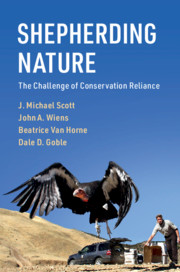Book contents
- Shepherding Nature
- Shepherding Nature
- Copyright page
- Contents
- Preface
- Acknowledgments
- 1 Extinction and the Challenge of Conservation Reliance
- 2 The Conservation Spectrum
- 3 The Genesis of Conservation Reliance and the Language of Conservation
- 4 What Are the Threats?
- 5 Emerging Threats in a Rapidly Changing World
- 6 The Role of Policy and Law
- 7 What’s in the Conservationist’s Toolbox: Species-Centered Approaches
- 8 Expanding the Conservationist’s Toolbox: Going Beyond Species
- 9 Conservation Reliance Is a Human Issue
- 10 Making Tough Decisions: Prioritizing Species for Conservation
- 11 Being a Good Shepherd
- Book part
- Essay Contributors
- References
- Index
5 - Emerging Threats in a Rapidly Changing World
Published online by Cambridge University Press: 28 February 2020
- Shepherding Nature
- Shepherding Nature
- Copyright page
- Contents
- Preface
- Acknowledgments
- 1 Extinction and the Challenge of Conservation Reliance
- 2 The Conservation Spectrum
- 3 The Genesis of Conservation Reliance and the Language of Conservation
- 4 What Are the Threats?
- 5 Emerging Threats in a Rapidly Changing World
- 6 The Role of Policy and Law
- 7 What’s in the Conservationist’s Toolbox: Species-Centered Approaches
- 8 Expanding the Conservationist’s Toolbox: Going Beyond Species
- 9 Conservation Reliance Is a Human Issue
- 10 Making Tough Decisions: Prioritizing Species for Conservation
- 11 Being a Good Shepherd
- Book part
- Essay Contributors
- References
- Index
Summary
In dealing with global changes—including climate, sea levels, and ocean chemistry—traditional approaches to managing species and threats may be unsuccessful. Acting on anticipated changes can improve management effectiveness. Rapid responses may be needed for some threats, such as the effects of extreme weather events. Disruption of ecological relationships among species is a consequence of extinctions and shifting habitats. When functions such as pollination, food provision, or predation are lost, humans may need to take them over a to prevent additional extinctions. Successful planning will account for range shifts and for barriers that include ridges, watercourses, and changing land uses. Species differ in their adaptive capacity in the face of global changes; some may benefit from translocation if suitable receiving habitat is available. Management intervention to build genetic diversity can also be beneficial. Scenario modeling and niche and demographic models can help to anticipate effects of global changes on species of concern. Such modeling can help to prioritize conservation actions designed to prevent imperilment or extinction. Changing regulations that fail to fully acknowledge global changes and associated conservation reliance is essential.
Keywords
- Type
- Chapter
- Information
- Shepherding NatureThe Challenge of Conservation Reliance, pp. 130 - 157Publisher: Cambridge University PressPrint publication year: 2020



